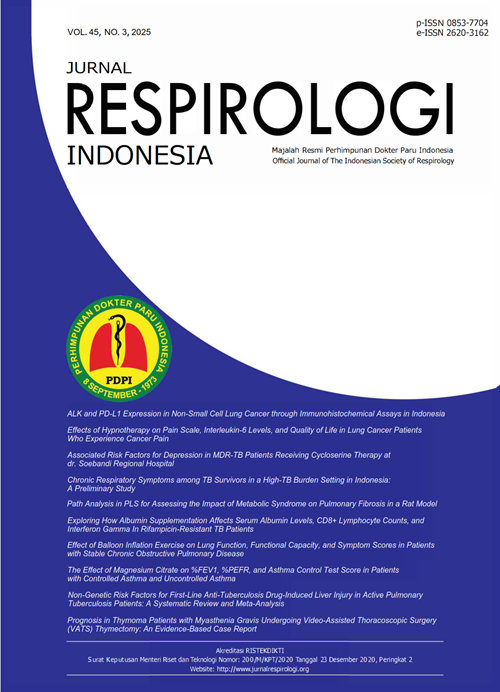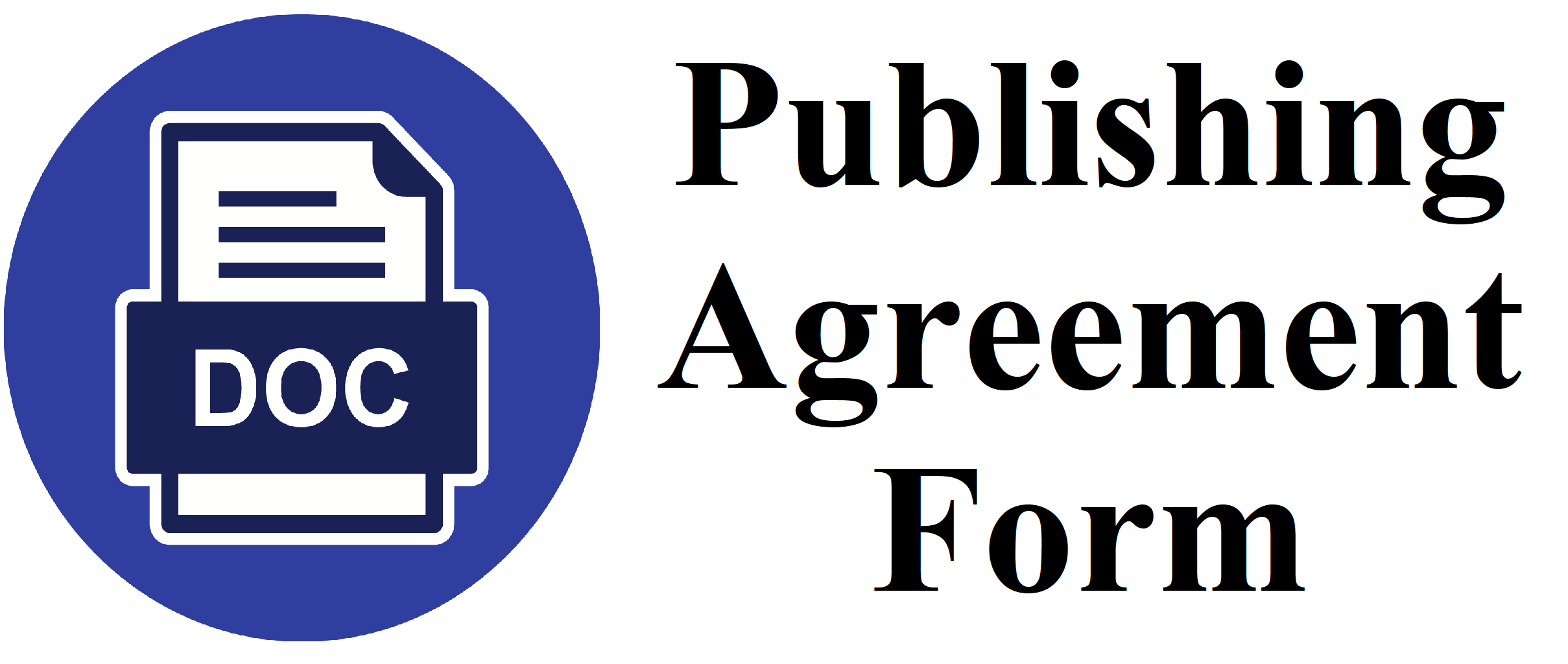Prognosis in Thymoma Patients with Myasthenia Gravis Undergoing Video-Assisted Thoracoscopic Surgery (VATS) Thymectomy: An Evidence-Based Case Report
DOI:
https://doi.org/10.36497/jri.v45i3.814Keywords:
CSR, myasthenia gravis, survival, thymoma, VATSAbstract
Background: Thymoma, a tumor in the anterior mediastinum, is common in adults and often linked with myasthenia gravis (MG). Thymectomy is recommended for MG patients with thymoma and traditionally done via median sternotomy, which is invasive. Minimally invasive methods like video-assisted thoracoscopic surgery (VATS) offer benefits like less blood loss and quicker recovery. However, more extensive studies are needed to confirm long-term oncological outcomes.
Methods: A literature search was conducted using PubMed, Cochrane, and Scopus databases focused on terms related to thymoma, myasthenia gravis, VATS thymectomy, and survival. Duplicates were excluded, and studies were selected based on criteria. The selected studies were then critically appraised for validity, importance, and applicability.
Results: Three manuscripts are selected for this case report. He et al showed that the cumulative CSR in the VATS group (26.7%) was significantly higher than the transsternal group (P=0.026). Maggi et al reported that the VATS group is significantly correlated with CSR (P=0.0349). Meanwhile, Tian et al showed there was no significant difference in the level of CSR (32.7% vs. 36.7%; P=0.622) between the VATS and trans-sternal groups. Tian et al also showed that survival results in the VATS group were higher than in the trans-sternal group, but it was not statistically significant (P=0.109).
Conclusion: The prognosis of thymoma patients with MG who undergo thymectomy using the VATS method is not significantly different compared with the trans-sternal method.
Downloads
References
1. Marx A, Weis CA, Ströbel P. Thymomas. Pathologe. 2016;37(5):412–24.
2. Lee HI, Jang IS, Jeon KN, Ko GH, Lee JS, Kim DC, et al. Thymoma and synchronous primary mediastinal seminomas with florid follicular lymphoid hyperplasia in the anterior mediastinum: A case report and review of the literature. J Pathol Transl Med. 2017;51(2):165–70.
3. Harris C, Croce B, Xie A. Thymoma. Ann Cardiothorac Surg. 2015;4(6):576.
4. Itani M, Goldman Gollan Y, Ezell K, Mohanna M, Sabbagh S, Mears C, et al. Thymoma and myasthenia gravis: An examination of a paraneoplastic manifestation. Cureus. 2023;15(2):e34828.
5. Menghesha H, Schroeter M, Nelke C, Ruck T, Schlachtenberger G, Welskop C, et al. The impact of thymectomy in subgroups of Myasthenia gravis patients: A single center longitudinal observation. Neurol Res Pract. 2023;5(1):24.
6. Yang CFJ, Hurd J, Shah SA, Liou D, Wang H, Backhus LM, et al. A national analysis of open versus minimally invasive thymectomy for stage I to III thymoma. Journal of Thoracic and Cardiovascular Surgery. 2020;160(2):555–67.
7. Imielski B, Kurihara C, Manerikar A, Chaudhary S, Kosterski S, Odell D, et al. Comparative effectiveness and cost-efficiency of surgical approaches for thymectomy. Surgery (United States). 2020;168(4):737–42.
8. Wang GW, Tao T, Li CK, Li QC, Duan GX, Sang HW, et al. Comparison between thoracoscopic and open approaches in thymoma resection. J Thorac Dis. 2019;11(10):4159–68.
9. Bedetti B, Solli P, Lawrence D, Panagiotopoulos N, Hayward M, Scarci M. Single port video-assisted thoracoscopic thymectomy. J Vis Surg. 2016;2:149.
10. Salahoru P, Grigorescu C, Hinganu MV, Lunguleac T, Halip AI, Hinganu D. Thymus surgery prospectives and perspectives in myasthenia gravis. J Pers Med. 2024;14(3):241.
11. Pupovac SS, Newman J, Lee PC, Alexis M, Jurado J, Hyman K, et al. Intermediate oncologic outcomes after uniportal video-assisted thoracoscopic thymectomy for early-stage thymoma. J Thorac Dis. 2020;12(8):4025–32.
12. He Z, Zhu Q, Wen W, Chen L, Xu H, Li H. Surgical approaches for stage I and II thymoma-associated myasthenia gravis: Feasibility of complete video-assisted thoracoscopic surgery (VATS) thymectomy in comparison with trans-sternal resection. J Biomed Res. 2013;27(1):62–70.
13. Maggi L, Andreetta F, Antozzi C, Baggi F, Bernasconi P, Cavalcante P, et al. Thymoma-associated myasthenia gravis: Outcome, clinical and pathological correlations in 197 patients on a 20-year experience. J Neuroimmunol. 2008;201–202(C):237–44.
14. Tian W, Li X, Tong H, Weng W, Yang F, Jiang G, et al. Surgical effect and prognostic factors of myasthenia gravis with thymomas. Thorac Cancer. 2020;11(5):1288–96.
15. National Comprehensive Cancer Network. Thymomas and thymic carcinomas - Guidelines version 1.2024 [Internet]. 2024 [cited 2024 Nov 1]. Available from: https://www.nccn.org/guidelines/guidelines-detail?category=1&id=1469
Downloads
Published
Issue
Section
License
Copyright (c) 2025 Susan Hendriarini Mety, Diajeng Permadijana, Muhammad Syawal Satria Ramli

This work is licensed under a Creative Commons Attribution-ShareAlike 4.0 International License.
- The authors own the copyright of published articles. Nevertheless, Jurnal Respirologi Indonesia has the first-to-publish license for the publication material.
- Jurnal Respirologi Indonesia has the right to archive, change the format and republish published articles by presenting the authors’ names.
- Articles are published electronically for open access and online for educational, research, and archiving purposes. Jurnal Respirologi Indonesia is not responsible for any copyright issues that might emerge from using any article except for the previous three purposes.
















